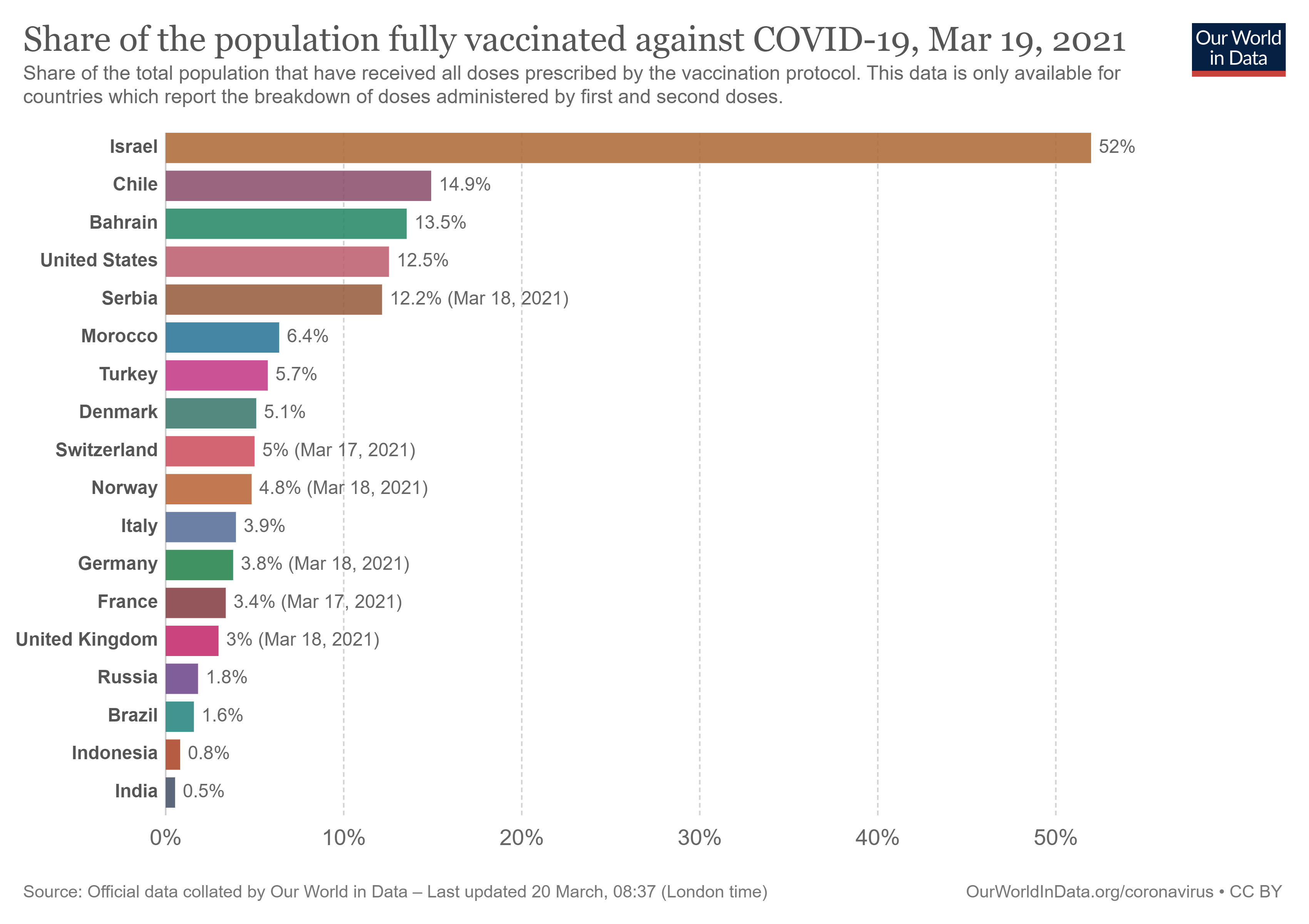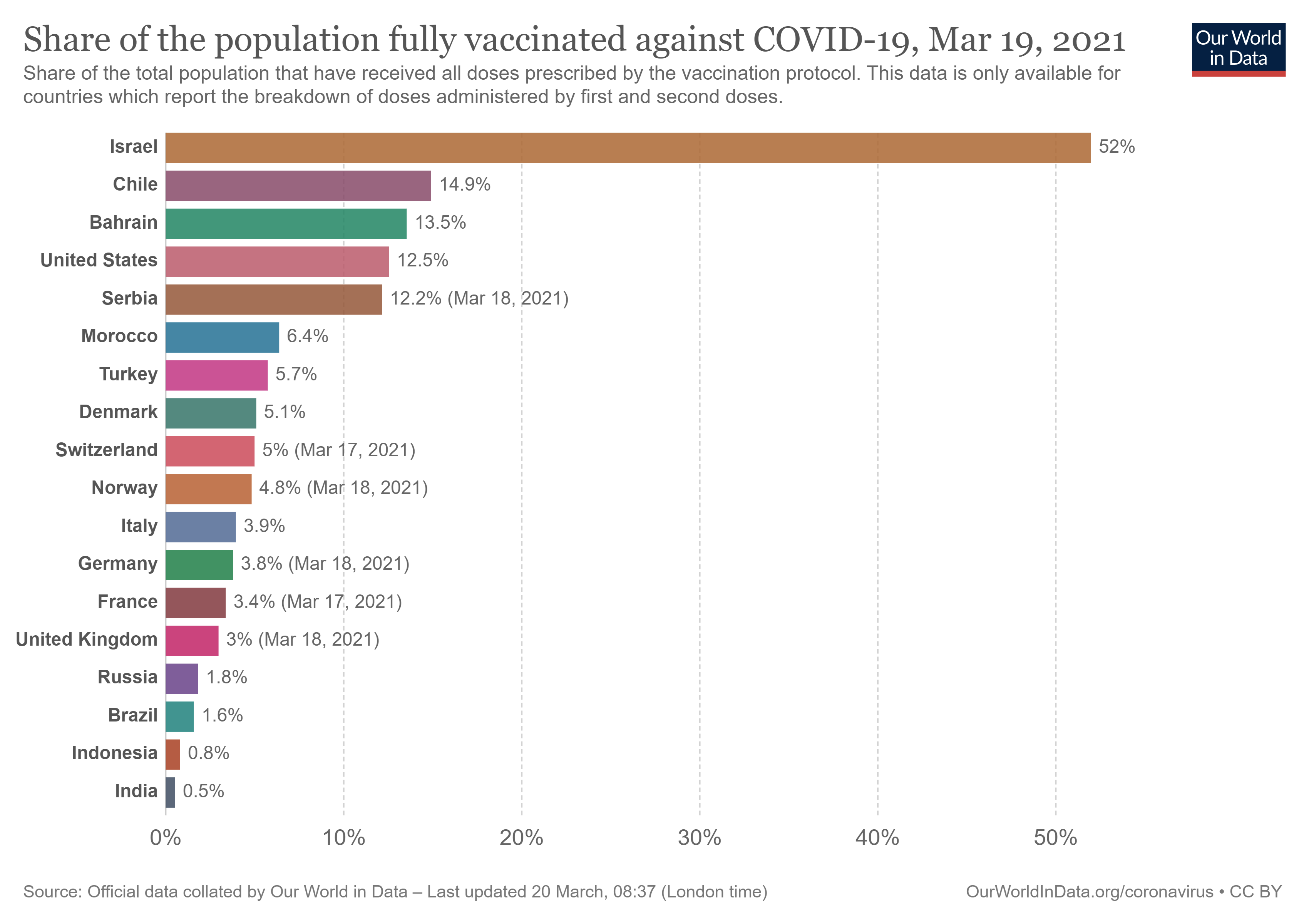Snapshot of COVID-19 Vaccination Around the World

Patricio V. Marquez and Betty Hanan
COVID-19 vaccination is critical to reduce the risk of infection and death due to COVID-19 disease, and hence for global economic recovery and normalization in social interactions and travel. Indeed, since a large share of the world needs to be immune to the virus, the COVID-19 vaccine deployment is requiring an unprecedented effort in terms of population coverage.
As we are currently observing in some rich countries, even with considerable doses of safe and effective vaccines on hand, countries face major challenges deploying these vaccines at scale. This situation is potentially challenging in low- and low-middle-income countries, where health systems are weak and resources, both financial and human, are limited.
For the successful implementation of COVID-19 vaccination programs, rigorous pre-planning for core functions and logistics is necessary. Besides the challenges associated with accessing vaccines in a still limited supply environment, mass vaccination roll-out requires: (i) robust supply systems to ensure effective vaccine reception, storage, handling, and stock management once vaccine doses have been secured; (ii) rigorous temperature controls across the supply chain; (iii) maintenance of adequate logistics management information systems, including robust service and coverage tracking systems to ensure traceability and address counterfeit vaccines; (iv) carefully planned deployment operations for vaccine transportation, reverse logistics, managing recalls, and management of supply chain information; (v) trained, motivated, and supervised vaccinators; (vi) a pharmacovigilance system to monitor adverse effects in the population after the administration of vaccines; (vii) tailored large-scale communication and outreach campaigns at household, community, and national levels to build trust and address vaccine hesitancy; (viii) citizen monitoring/oversight by publicizing detailed vaccination information on a regular basis; and (ix) grievance redress mechanisms. All these are vital to safeguard the COVID-19 vaccine supply and prevent any interruptions in the supply chain from the point of manufacturing to vaccine administration, to post-vaccination monitoring and evaluation.
The complexity of the task is further aggravated by hesitance on the part of population groups to receive the vaccine. And, as press reports in different countries have been informing, the risk of elite capture in access to vaccines is significant. For example, in a few countries in South America, ministers of health and other high-level officials, including a former President, have been fired or resigned for their involvement in scandals over coronavirus vaccine queue-jumping.
So where does the effort stand at this moment?
Despite the above challenges, progress is being made. But the risk of a growing inequity in the world for accessing, deploying, and administering COVID-19 vaccines, that may leave the poorest regions behind along with vulnerable population groups within rich and poor countries alike, is becoming more visible and worrisome. And the reality of isolated cases of adverse effects in recipients of COVID-19 vaccines cannot be discounted as they may hinder the implementation of vaccination programs and add to the mistrust of some people to getting vaccinated.
Based on vaccination data from the Our World in Data site, some highlights are provided to illustrate where the global effort stands at this moment.
First and foremost, the scientific and technological “miracle” that allowed vaccines to be developed and deployed in 12 months, is a historical “giant step for humanity.” Let’s keep in mind, that the development of new vaccines in the past has typically required years of research and testing before deployment and use.
Second, the vaccination effort has been initiated in more than 140 countries, albeit with still limited population coverage. Beginning in December 2020, more than 420 million vaccine doses had been administered worldwide in just three months, equal to 5.40 doses for every 100 people.
Third, in terms of population coverage, data shows:
- 251.84 million or about 3.2% of the total population in the world have received at least one dose of a COVID-19 vaccine.
- 97.61 million or just 1.3% of the total population in the world have been fully vaccinated.
- There is already a stark gap between vaccination programs in different countries and across regions, with many yet to report a single dose: 21.76% of the total vaccine doses have been administered in North America (mainly the United States) and 12.54% in Europe, compared to South America (6.28%), Asia (3.44%), Africa (0.60%), and Oceania (0.4%).
- While the supply of vaccine doses remain relatively limited globally, most countries have focused their early vaccination efforts on priority groups like the clinically vulnerable; people in their 60s, 70s and older; and front-line workers, like doctors and nurses. Most of the vaccines currently in use require two doses for a patient to be fully vaccinated.
Fourth, some of the COVID-19 vaccines being used have received emergency use authorization (EUA) from Stringent Regulatory Authorities (SRA) included in the World Health Organization (WHO) list of SRA, and/or have received emergency use listing (EUL) by WHO as well. The concept of a SRA was developed by the WHO Secretariat and the Global Fund to Fight AIDS, Tuberculosis and Malaria to guide medicine procurement decisions and is now widely recognized by the international regulatory and procurement community. That is the case of the Pfizer-BioNTech, Moderna, Oxford-AstraZeneca, and Johnson & Johnson vaccines. However, as shown in the box below, there are other COVID-19 vaccines that have been approved only by National Regulatory Authorities (NRA) that are not included in the WHO SRA list, which is allowing market entry and their use in several countries.

Source:
https://www.nytimes.com/interactive/2020/science/coronavirus-vaccine-tracker.
htmlhttps://www.cnn.com/2021/03/03/americas/cuba-covid-vaccine-soberana-intl-latam/index.htmlhttps://www.cnn.com/2021/03/03/americas/cuba-covid-vaccine-soberana-intl-latam/index.html
Fifth, there are several countries that are currently leading the world in the vaccination effort. As shown in the figures below, the share of the total population that received at least one vaccine dose in the five “leading countries” (those with 20% and higher coverage as of today), ranges from a high of 59.6% in Israel, 38.7% in the United Kingdom, 29.1% in Chile, 23.3% in Bahrain, and 23.1% in the United States.
In terms of the share of the total population that have received all doses prescribed by the vaccination protocol, it ranges in the five “leading countries” (those with 10% and higher coverage as of today), from a high of 52% in Israel, 14.9% in Chile, 13.5% in Bahrain, 12.5% in the United States, and 12.2% in Serbia.


While the “leading countries” have made significant gains in expanding vaccination coverage, in most cases relying on the strength of pre-existing, well-structured health systems that offer universal coverage to the population, as in the case of Israel, Chile, and the United Kingdom, most countries in the world are lagging. This is clearly illustrated in the table below, that shows that in countries such as Afghanistan, Ecuador, Kenya, Lao, Tunisia, and Uganda, the share of the population that has received at least one dose of the COVID-19 vaccine is less than 1%.

Sixth, given limitations in the supply of vaccines, disparities in the pace and coverage of the vaccination effort across the world, and the looming threat of virus variants that are found to be deadlier, more contagious, and more resistant to vaccines, it is critical to stress that while we should be optimistic about the impact of vaccines in helping build herd immunity in countries, governments need to continue to support essential public health measures such as the use of masks, hand hygiene, and physical distancing. These are highly cost-effective measures that complement vaccines in the fight against the ongoing pandemic, reducing the spread of the coronavirus and preventing disease and death.
So, let’s be clear: while progress is being made, we are not yet close to suppressing the coronavirus or in a situation where we can claim victory and return to the “normal life” of the recent past!
